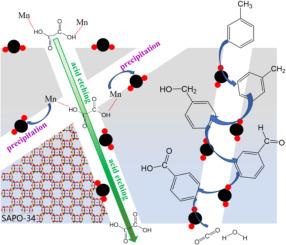Optimizing mass-transfer and oxygen components to enhance toluene oxidation for MnOx/SAPO-34 and revealing mechanism by in-situ DRITFS
IF 5.7
2区 材料科学
Q2 CHEMISTRY, PHYSICAL
引用次数: 0
Abstract
A series of MnOx/SAPO-34 was synthesized using deposition-precipitation method with acid, alkali, saline to modify their physicochemical property enhancing the performance for toluene oxidation. The structure-activity relationship was explored in depth using variant instruments. It was found that the SAPO-34 was etched by desiliconization with oxalic acid as precipitant and converting its micropores into mesopores as well as macropores, which is not only conducive to anchoring and dispersion of more active MnOx, but also promote the mass transfer of reactants. Meanwhile, the catalyst derived from oxalic acid possesses abundant redox sites with the strongest low temperature reducibility. As the results, the Mn/S34-OA exhibits the best performance of toluene oxidation with T90=237 °C and ∼100 % CO2 selectivity. Besides, the catalyst maintained long-term stability even in presence of H2O at 260 °C. Furthermore, the reaction mechanism is revealed by in-situ DRIFTS experiments. It is demonstrated that lattice oxygen directly participates in oxidation of toluene as the crucial active component in path of toluene to benzyl alcohol to benzaldehyde to benzoic acid to CO2 finally. In addition, the consumed lattice oxygen is replenished by adsorbed gaseous O2, which is the key to maintain continuous reaction cycle.

通过原位 DRITFS 优化 MnOx/SAPO-34 的传质和氧组分以增强甲苯氧化能力并揭示其机理
利用沉积-沉淀法合成了一系列 MnOx/SAPO-34,并使用酸、碱和盐水来改变其物理化学性质,以提高其甲苯氧化性能。利用不同的仪器对其结构-活性关系进行了深入探讨。研究发现,以草酸为沉淀剂对 SAPO-34 进行脱硅蚀刻,将其微孔转化为中孔和大孔,这不仅有利于更多活性氧化锰的锚定和分散,还能促进反应物的传质。同时,草酸衍生催化剂具有丰富的氧化还原位点,低温还原性最强。结果表明,Mn/S34-OA 的甲苯氧化性能最佳,T90=237 °C,二氧化碳选择性高达 100%。此外,即使在 260 ℃ 下有 H2O 存在,催化剂也能保持长期稳定性。此外,原位 DRIFTS 实验还揭示了反应机理。实验证明,晶格氧直接参与了甲苯的氧化,是甲苯到苯甲醇到苯甲醛到苯甲酸再到二氧化碳这一过程中的关键活性成分。此外,消耗掉的晶格氧还能通过吸附的气态氧气得到补充,这是维持连续反应循环的关键。
本文章由计算机程序翻译,如有差异,请以英文原文为准。
求助全文
约1分钟内获得全文
求助全文
来源期刊

Surfaces and Interfaces
Chemistry-General Chemistry
CiteScore
8.50
自引率
6.50%
发文量
753
审稿时长
35 days
期刊介绍:
The aim of the journal is to provide a respectful outlet for ''sound science'' papers in all research areas on surfaces and interfaces. We define sound science papers as papers that describe new and well-executed research, but that do not necessarily provide brand new insights or are merely a description of research results.
Surfaces and Interfaces publishes research papers in all fields of surface science which may not always find the right home on first submission to our Elsevier sister journals (Applied Surface, Surface and Coatings Technology, Thin Solid Films)
 求助内容:
求助内容: 应助结果提醒方式:
应助结果提醒方式:


